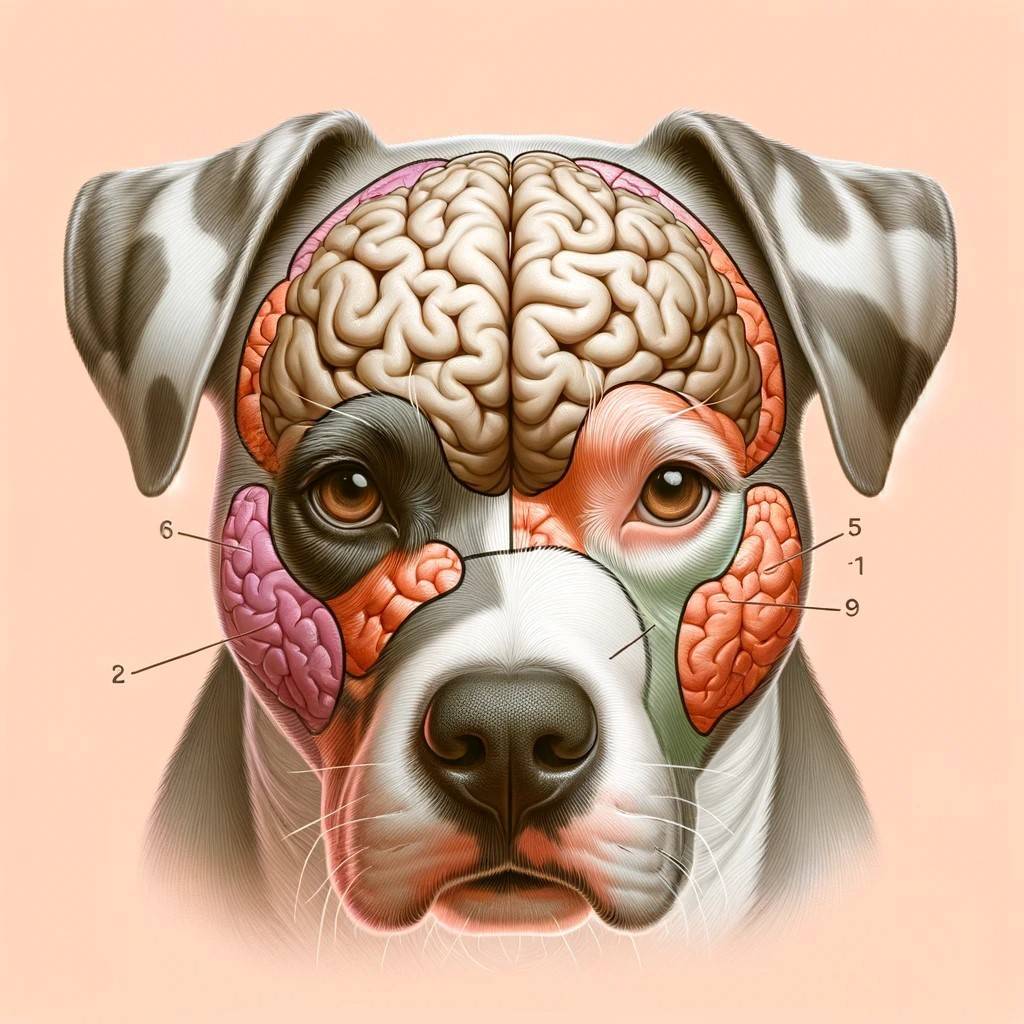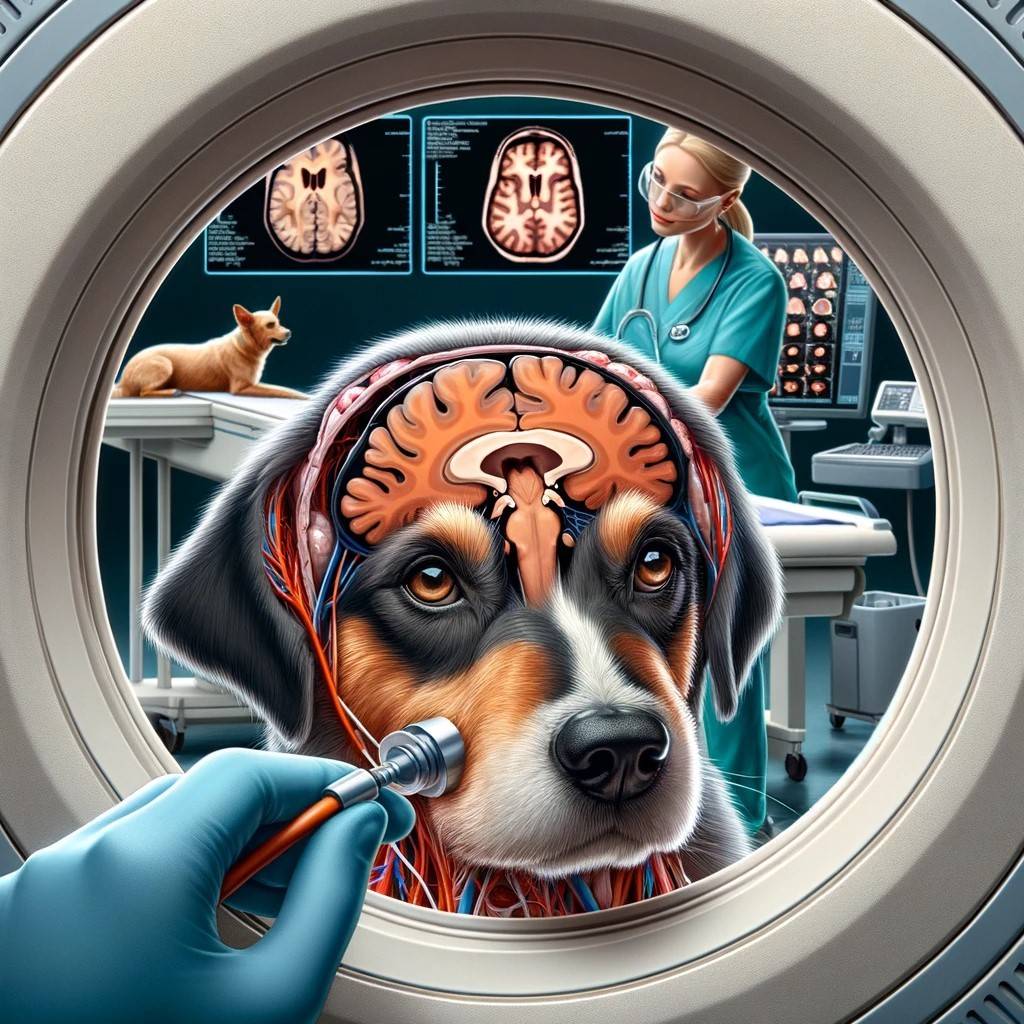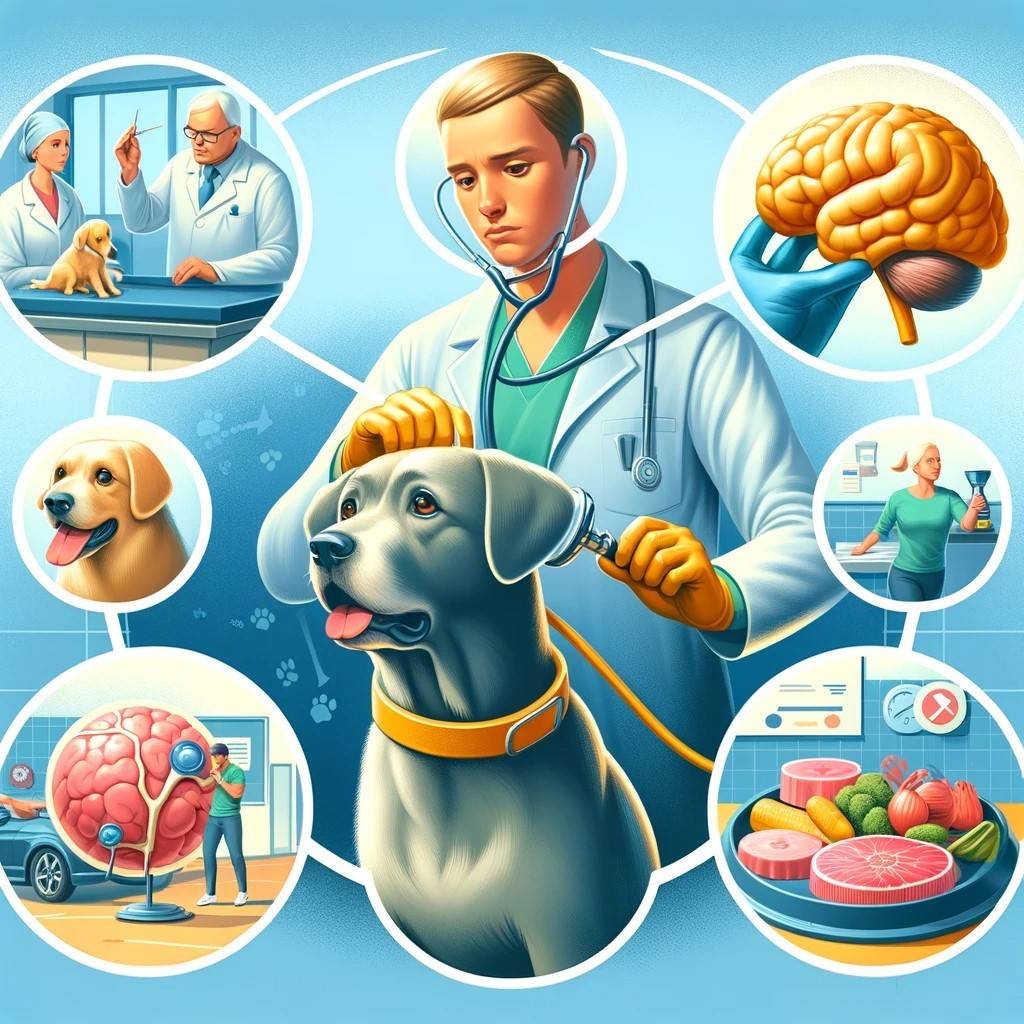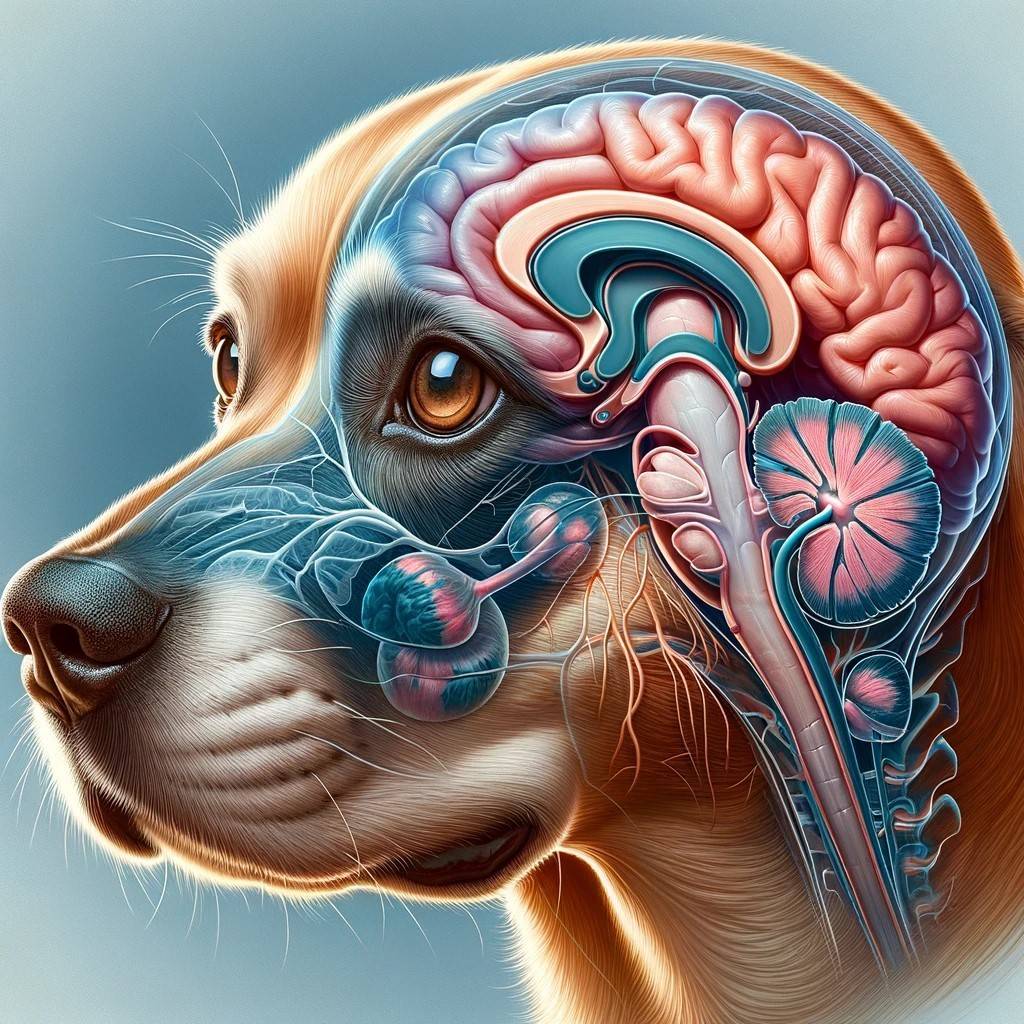Understanding the Symptoms of Brain Tumor in Dogs: A Comprehensive Guide for Pet Owners
As pet owners, we must recognize the early signs of a brain tumor in our beloved dogs. Brain tumor can significantly affect the quality of life of our furry friends. This comprehensive guide aims to provide valuable insights into the symptoms of a brain tumor in dogs, equipping every concerned pet parent with the knowledge they need.
What Causes Symptoms of Brain Tumor in Dogs?

Symptoms of Brain Tumor in Dogs are abnormal growths that occur within the brain or the surrounding membranes. These tumors can be primary, originating in the brain, or secondary, spreading from other body parts. While primary brain tumors are less common, both types can have devastating effects.
Types of Brain Tumors in Dogs
- Meningiomas: These tumors arise from the protective membranes of the brain, known as the meninges.
- Gliomas: Originating from glial cells within the brain.
- Pituitary adenomas: Tumors that affect the pituitary gland.
Risk Factors
- Age: Older dogs are more susceptible to developing brain tumors.
- Breed: Certain breeds, such as Boxers, Golden Retrievers, and Boston Terriers, are at a higher risk.
Prevalence
- Brain tumors account for approximately 2-5% of all canine cancers.
Recognizing the Red Flag: Symptoms of Brain Tumor in Dogs
The symptoms of a brain tumor in dogs can vary depending on the tumour’s location and size. However, there are some common signs and symptoms to watch out for:
Neurological Symptoms
- Seizures: Sudden and uncontrolled muscle contractions, often accompanied by loss of consciousness.
- Head tremors or shaking: Uncontrollable shaking of the head, sometimes accompanied by jerking of the body.
- Loss of balance or coordination: Difficulty walking, stumbling, or falling.
- Walking in circles or disorientation: Inability to navigate familiar surroundings, walking in circles, or bumping into objects.
- Pacing or restlessness: Excessive pacing, restlessness, or inability to settle.
- Head pressing: Pressing the head against walls or other objects, often accompanied by vocalization.
Behavioural Changes
- Lethargy or fatigue: Decreased energy levels, excessive sleeping, or reluctance to engage in activities.
- Decreased appetite or weight loss: Loss of appetite, weight loss, or changes in eating habits.
- Changes in sleep patterns: Sleep disturbances, sleeping too much or too little, or restless sleep.
- Aggression or unprovoked behaviour: unprovoked aggression, biting, snapping, or growling.
- Hiding or withdrawing from social interactions: Avoiding people or other animals, hiding in secluded places.
- Excessive vocalization (whining, barking): Whining, barking, or howling excessively, especially without apparent cause.
Vision Problems
- Bumping into objects or walls: Difficulty navigating familiar surroundings, bumping into objects or walls.
- Difficulty navigating familiar surroundings: Finding food, water, or familiar objects is hard.
- Dilated pupils or unusual eye movements: enlarged, uncontrollable, or unusual eye twitching.
- Partial or complete vision loss: Loss of vision in one or both eyes, difficulty seeing in low light.
Headaches and Facial Signs
- Pain or discomfort in the head area: whining, pawing at the head, or showing signs of discomfort.
- Tilting the head to one side: Holding the head at an unusual angle, indicating pain or pressure in one side of the brain.
- Facial paralysis or drooping: Drooping of one side of the face, inability to close one eye, or weakness in facial muscles.
- Difficulty swallowing or chewing: Difficulty eating, dropping food, or choking.
Finally, after exploring the Symptoms of Brain Tumor in Dogs As an owner, I want to know when to seek Veterinary.
When to Seek Veterinary Attention
If you notice any of the symptoms mentioned above, it is crucial to seek veterinary attention promptly. Early diagnosis and treatment can significantly improve the chances of a successful outcome. Here are some specific instances when immediate veterinary care is warranted:
- Sudden onset of neurological symptoms: seizures, head tremors, loss of balance, or other sudden neurological changes require immediate attention.
- Severe behavioural changes: Sudden aggression, hiding, or excessive vocalization warrant prompt evaluation.
- Vision problems: Bumping into objects, difficulty navigating, or changes in eye appearance should be addressed immediately.
- Headaches or facial signs: Signs of head pain or facial weakness require immediate veterinary attention.
Diagnosis of the symptoms of brain tumor in dogs

Early diagnosis plays a key role in managing symptoms of brain tumor in dogs. The diagnostic process usually involves:
- Veterinary Examination: A thorough neurological exam assesses reflexes and brain function.
- Diagnostic Tests: MRI and CT scans are crucial for an accurate diagnosis.
Fact: MRI is considered the gold standard for diagnosing brain tumors in dogs.
Addressing Symptoms of Brain Tumor in Dogs: Treatment Options
Treatment for brain tumors in dogs varies depending on the type and location of the tumor. It may include:
- Surgical Interventions: Removal of accessible tumors through surgery.
- Radiation Therapy: Used post-surgery or for inoperable tumors.
- Chemotherapy: Used in conjunction with other treatments.
- Supportive Care: Focused on enhancing quality of life and managing symptoms.
Prognosis and Managing Symptoms of Brain Tumor in Dogs
The prognosis for a dog with a brain tumor depends on various factors, including the tumour’s type, size, location, and overall health of the dog. Treatment response also plays a significant role. Some influencing factors are:
- Type of tumor: Benign tumors often have a better prognosis than malignant ones.
- Response to Treatment: Dogs that respond well to treatment may have a longer life expectancy.
Life Expectancy Post-Diagnosis
The life expectancy for dogs with brain tumors can range from a few months to several years, depending on various factors.
Preventing Symptoms of Brain Tumor in Dogs

While it’s challenging to prevent brain tumors in dogs, certain steps can contribute to overall health:
- Regular Veterinary Check-Ups: Essential for early detection of any abnormalities.
- Diet and Lifestyle: A balanced diet and regular exercise can enhance a dog’s overall well-being.
Tip: Consult with a veterinarian to create a personalized health plan for your dog.
Coping with a Diagnosis: Support for Dog Owners
Receiving a diagnosis of symptoms of brain tumor in your dogs can be an overwhelming experience. Here are some ways to navigate this challenging time:
- Emotional Impact: Acknowledge your feelings and seek support from friends, family, or pet support groups.
- Finding Resources: Look for online communities and forums for advice and shared experiences.
- Making Decisions: Work closely with your veterinarian to make informed choices about your dog’s care.
Quote: “In the face of such challenges, the love, and care we provide to our pets can make a profound difference in their lives and ours.” – Dr. Jane Smith, DVM
Conclusion
Recognizing the symptoms of brain tumor in dogs early can have a significant impact on the management and treatment of this condition. Pet owners need to stay informed and vigilant. Remember, your veterinarian is your best resource for any concerns or questions about your pet’s health.
FAQs about Symptoms of Brain Tumor in Dogs
Here are the common frequently asked questions about “Symptoms of Brain Tumor in Dogs” and the best answers.
| Q: How long will a dog live with a brain tumour?
A: The lifespan of a dog with a brain tumor can vary widely. It depends on the type of tumor, its location, and how advanced it is when diagnosed. Some dogs might live for several months or even years with treatment, like surgery or chemotherapy. Remember, each dog is unique, so it’s always best to discuss your dog’s specific situation with a vet. Q: Are dogs with brain tumors in pain? A: for sure since dogs can’t tell us how they feel. But brain tumours can cause discomfort or pain, especially if they’re causing pressure inside the brain. Symptoms like changes in behaviour or appetite might show your dog is in discomfort. If you suspect your dog is in pain, it’s important to consult your vet immediately for advice and treatment options. Q: What are the first-stage symptoms of a brain tumor? A: Early symptoms of a brain tumor in dogs can be subtle. You might notice changes like slight behavioural shifts, loss of balance, or occasional seizures. These early signs can easily be missed or mistaken for other issues, so it’s key to keep an eye on any unusual changes in your dog’s behaviour or health. Q: How do dogs act when they have a tumour? A: Dogs with brain tumors might show various signs. Some common behaviours include being confused or disoriented, having difficulty walking or standing, and experiencing seizures, or vision changes. Remember, these symptoms can also be related to other health issues, so a vet check-up is crucial for a proper diagnosis. Q: What age can a dog get a brain tumour? A: Brain tumors are more common in older dogs, typically starting to show up in dogs over the age of 5. However, they can occur at any age. Some breeds might be at a higher risk, so it’s good to stay informed about your dog’s specific breed health concerns. Q: What are the final stages of a brain tumor? A: In the final stages of a brain tumor, symptoms can become more severe. Dogs might experience frequent or severe seizures, significant coordination problems, or even paralysis. They might also show signs of pain or distress. It’s a tough phase for any pet owner, and providing comfort and quality care for your dog is crucial.
|
|



